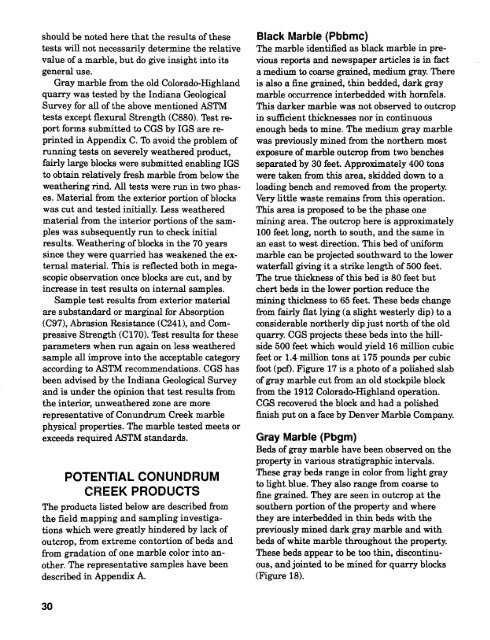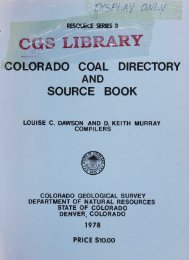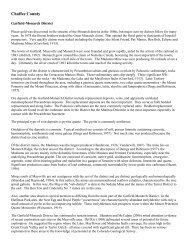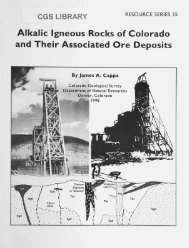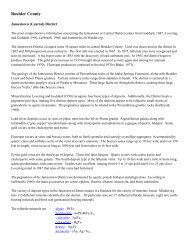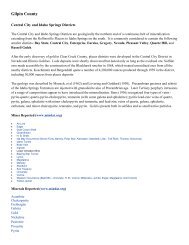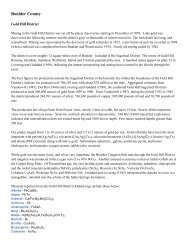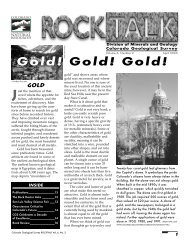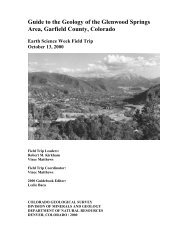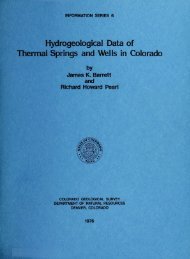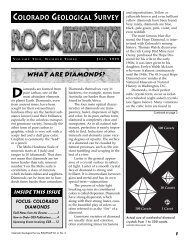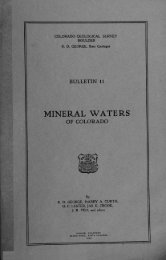Marble - Colorado Geological Survey
Marble - Colorado Geological Survey
Marble - Colorado Geological Survey
You also want an ePaper? Increase the reach of your titles
YUMPU automatically turns print PDFs into web optimized ePapers that Google loves.
should be noted here that the results of these<br />
tests will not necessarily determine the relative<br />
value of a marble, but do give insight into its<br />
general use.<br />
Gray marble from the old <strong>Colorado</strong>-Highland<br />
quarry was tested by the Indiana <strong>Geological</strong><br />
<strong>Survey</strong> for all of the above mentioned ASTM<br />
tests except flexural Strength (C880). Test report<br />
forms submitted to CGS by IGS are reprinted<br />
in Appendix C. To avoid the problem of<br />
running tests on severely weathered product,<br />
fairly large blocks were submitted enabling IGS<br />
to obtain relatively fresh marble from below the<br />
weathering rind. All tests were run in two phases.<br />
Material from the exterior portion of blocks<br />
was cut and tested initially. Less weathered<br />
material from the interior portions of the samples<br />
was subsequently run to check initial<br />
results. Weathering of blocks in the 70 years<br />
since they were quarried has weakened the external<br />
material. This is reflected both in megascopic<br />
observation once blocks are cut, and by<br />
increase in test results on internal samples.<br />
Sample test results from exterior material<br />
are substandard or marginal for Absorption<br />
(C97), Abrasion Resistance (C241), and Compressive<br />
Strength (C170). Test results for these<br />
parameters when run again on less weathered<br />
sample all improve into the acceptable category<br />
according to ASTM recommendations. CGS has<br />
been advised by the Indiana <strong>Geological</strong> <strong>Survey</strong><br />
and is under the opinion that test results from<br />
the interior, unweathered zone are more<br />
representative of Conundrum Creek marble<br />
physical properties. The marble tested meets or<br />
exceeds required ASTM standards.<br />
POTENTIAL CONUNDRUM<br />
CREEK PRODUCTS<br />
The products listed below are described from<br />
the field mapping and sampling investigations<br />
which were greatly hindered by lack of<br />
outcrop, from extreme contortion of beds and<br />
from gradation of one marble color into another.<br />
The representative samples have been<br />
described in Appendix A.<br />
30<br />
Black <strong>Marble</strong> (Pbbmc)<br />
The marble identified as black marble in previous<br />
reports and newspaper articles is in fact<br />
a medium to coarse grained, medium gray. There<br />
is also a fine grained, thin bedded, dark gray<br />
marble occurrence interbedded with hornfels.<br />
This darker marble was not observed to outcrop<br />
in sufficient thicknesses nor in continuous<br />
enough beds to mine. The medium gray marble<br />
was previously mined from the northern most<br />
exposure of marble outcrop from two benches<br />
separated by 30 feet. Approximately 400 tons<br />
were taken from this area, skidded down to a<br />
loading bench and removed from the property.<br />
Very little waste remains from this operation.<br />
This area is proposed to be the phase one<br />
mining area. The outcrop here is approximately<br />
100 feet long, north to south, and the same in<br />
an east to west direction. This bed of uniform<br />
marble can be projected southward to the lower<br />
waterfall giving it a strike length of 500 feet.<br />
The true thickness of this bed is 80 feet but<br />
chert beds in the lower portion reduce the<br />
mining thickness to 65 feet. These beds change<br />
from fairly flat lying (a slight westerly dip) to a<br />
considerable northerly dip just north of the old<br />
quarry. CGS projects these beds into the hillside<br />
500 feet which would yield 16 million cubic<br />
feet or 1.4 million tons at 175 pounds per cubic<br />
foot (pel). Figure 17 is a photo of a polished slab<br />
of gray marble cut from an old stockpile block<br />
from the 1912 <strong>Colorado</strong>-Highland operation.<br />
CGS recovered the block and had a polished<br />
finish put on a face by Denver <strong>Marble</strong> Company.<br />
Gray <strong>Marble</strong> (Pbgm)<br />
Beds of gray marble have been observed on the<br />
property in various stratigraphic intervals.<br />
These gray beds range in color from light gray<br />
to light blue. They also range from coarse to<br />
fine grained. They are seen in outcrop at the<br />
southern portion of the property and where<br />
they are interbedded in thin beds with the<br />
previously mined dark gray marble and with<br />
beds of white marble throughout the property.<br />
These beds appear to be too thin, discontinuous,<br />
and jointed to be mined for quarry blocks<br />
(Figure 18).


